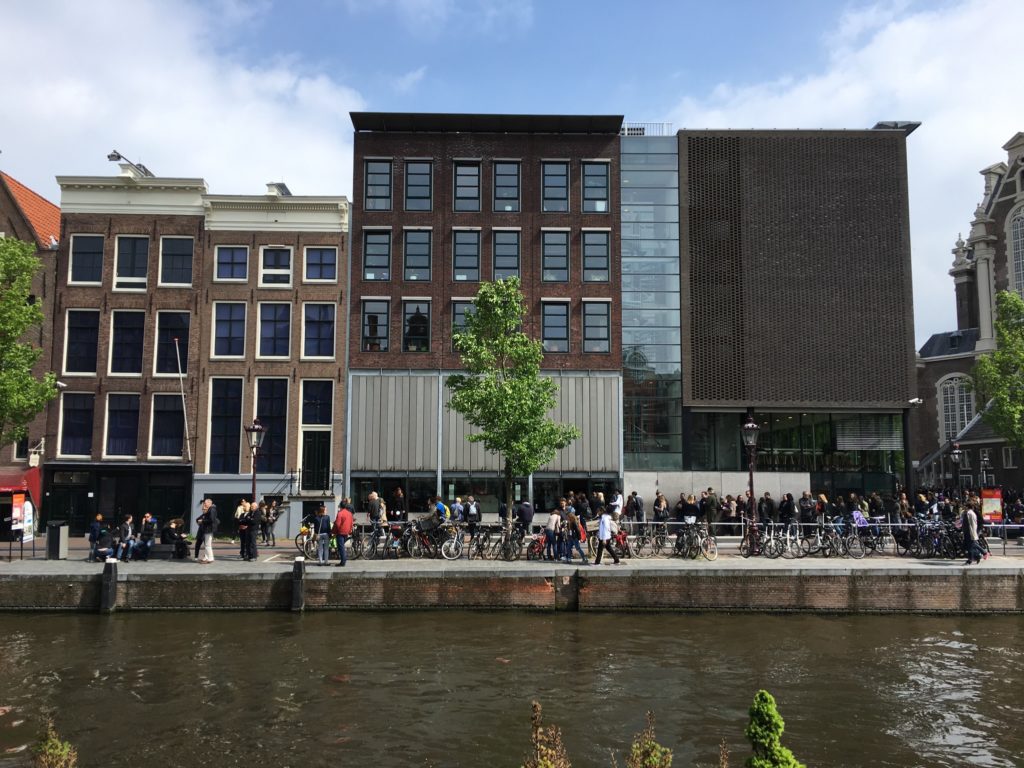The Anne Frank House
By Lauren Joseph
On the outside, the Anne Frank house looks like any other house on the streets of Amsterdam. Walking through it, though, will take visitors to a whole other world, a world that is hard to imagine. The International Media class of 2016 at Point Park University experienced this heart-rending museum first hand.
The long line to enter the house wrapped around several buildings. The area around the house was just as beautiful as every other street in the city of Amsterdam. There are views of canals, a massive church and charming houses.
The Anne Frank House opened in May 1960 and is open every day except during Yom Kippur. With the house receiving 1.2 million visitors every year, the employees are kept busy greeting and serving people from around the world. But they say their work, informing both public and press about Anne Frank, the Secret Annex and WWII is a calling.
Irith Halm, a communications employee at the house, wrote in an email, “It feels like doing the right thing and doing valuable, important work. Anne was a lively girl, just like any other girl of her age. Try to read her diary and afterwards visit the Anne Frank House.”
Westerkerk, the church located almost right next to the house, was mentioned often in Anne’s diary. She could see the steeple from the attic above their annex, her touch to the outside world. She also mentioned that the bells were taken from the church and melted down for the war.
After nearly two hours in line, students were able to walk through the museum dedicated to the Frank family and their friends in hiding with them. In the first room of the house, students saw a quote from Anne Frank’s diary: “I know what I want, I have a goal, an opinion, I have a religion and love. Let me be myself and then I am satisfied. I know that I’m a woman, a woman with inward strength and plenty of courage.”
This quote, next to a picture of Anne Frank smiling, set the tone for the entire visit: The house was home to a young girl who was smart, opinionated, and passionate about her ambitions, something her father, Otto Frank, realized when he decided to publish her book in 1947.
Every room in the house painted a picture of what life was like during the two years in hiding. The rooms had no furniture but still felt small. The windows remained covered, similar to how they were needed to be covered while they were occupied by Anne and her family and housemates. One of the rooms had two sets of doll-sized replicas of the house representing what it looked like when it was furnished. Otto Frank, when he decided to turn the house into a museum, wanted the rooms to remain empty, but he also wanted people to see how the house looked when his family and friends were living there.
Students learned about the helpers who kept Anne and her housemates safe from harm and how they had to be silent throughout the day – barely moving about the space – when employees were downstairs working in the jam factory her father owned. They saw pictures of everyone who played a role in their survival.
On Aug. 4, 1944, everyone in the Secret Annex was arrested. Someone had betrayed them, according to the Anne Frank House website. They were deported first to the Westerbork transit camp and then on to Auschwitz. The identity of their betrayer has never been established.
The house included a video of Anne’s friend Hannah Gosler talking about how she found Anne in the camp next to her, took her a package to cheer her up, and then never heard from her again.
Anne and her sister Margot were taken later to the Bergen-Belsen concentration camp. Anne died there in February 1945 at 15. Otto Frank was the only person from the Secret Annex to survive the camps.
On the tour Otto Frank’s video explained his surprise in the depth and maturity of Anne’s diary: “It took me a very long time to read it, and I must say I was very much surprised about the deep thoughts Anne had, her seriousness especially her self-criticism. It was quite a different Anne than I had known as my daughter.” He said in the interview that he never knew that Anne had such strong opinions, wrote so articulately, and felt so deeply about becoming a writer. He concluded with saying that parents never truly know their children.
As the students left the museum they discussed how moving the experience was for them. Hannah Altman, a senior photography major, felt that she had a deep connection with Anne Frank.
“Visiting the Anne Frank house was a very personal experience, for sure,” she said. She and I have a lot in common, for better or worse. Walking through the house and fully understanding that I would share the same fate as the Frank family was very humbling.
“The end of the house tour concluded in a sign that said ‘her would haves are our opportunities,’ which I took to heart. Anne could not live her own life because she was Jewish, young and female. I am all of those things, about to embark on owning my own business and being a full-time artist. The Anne Frank house inspired me to live out my ambitions for her and myself.”
